
The coat of arms of Poznań consists of white city walls with three towers. On the left (heraldic) tower stands Saint Peter with a key and on the heraldic right one stands Saint Paul with a sword. In the gate there are two golden crossed keys with a cross above. Over the middle tower, which contains a single window and is topped by a battlement, there is a gothic shield with a white eagle in crown. On the sides of the two saints there are golden crescents and stars. All of those elements are on a blue field. Over the shield there is golden crown. Author of modern version of coat of arms is Jerzy Bąk.

The coat of arms that serves as the symbol of the Lublin Voivodeship, Poland depicts a white (silver) male jumping cervus (deer), with a yellow (golden) crown on its neck, placed on a red background. The current design of the coat of arms was designed by Andrzej Heidrich, and adopted in 2002.

The coat of arms of the city of Gdańsk, in its current form, dates back to 1410 and Banderia Prutenorum. The coat of arms is very similar to the flag of Gdańsk. It depicts two silver crosses on a red shield above each other, above which hovers a golden crown. The greater arms also has two lions as supporters and Gdańsk motto.

The coat of arms of the Lesser Poland Voivodeship, Poland features a white (silver) eagle with a yellow (golden) crown on his head that is turned left, a beak, legs, and a stripes on its wings, with the charge placed on the red background. It was designed by Wojciech Drelicharz, Zenon Piech, and Barbara Widłak, and adopted in 1999.

The flag of Poznań is a rectangular piece of white material with the coat of arms of the city placed in the middle. It was adopted in 1997.

The coat of arms of the Greater Poland Voivodeship, Poland features a white (silver) eagle with its head turned left, and raised wings, that has a yellow (golden) beak, legs, stripes on its wings, and a ring on its tail. The charge is placed in a red Heater style escutcheon with square top and acute base. It was adopted in 2000.

The coat of arms, that serves as the symbol of the Opole Voivodeship, Poland, features a yellow (golden) eagle wearing a yellow (golden) crown, placed on a blue background. It was adopted in 2001.
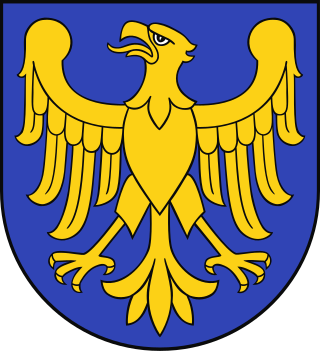
The coat of arms, that serves as the symbol of the Silesian Voivodeship, Poland, features a yellow (golden) eagle on a blue background. The current version of the coat of arms was adopted in 2001, and based on the historical coats of arms of Upper Silesia.

The coat of arms that serves as the symbol of the city of Szczecin in West Pomeranian Voivodeship, Poland depicts the head of a red griffin with a yellow (golden) beak wearing a yellow (golden) crown, placed on the blue background.

The flag is the symbol of the city of Szczecin in West Pomeranian Voivodeship, Poland.
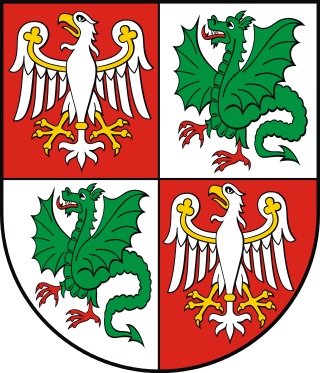
The coat of arms and the flag that serve as the symbols of the Warsaw West County, Masovian Voivodeship, in east-central Poland.

The coat of arms of the Kuyavian-Pomeranian Voivodeship, Poland, consists of a white (silver) escutcheon, with a half of an eagle facing left, joined with a half of a lion facing right, both animals together wearing a yellow (golden) crown on their joined heads. It had been adopted in 2000.
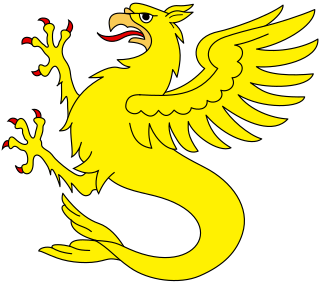
The sea-griffin is a heraldic charge in form of an aquatic griffin with the head, upper-half, wings, and talons of an eagle and the lower-half of a fish.
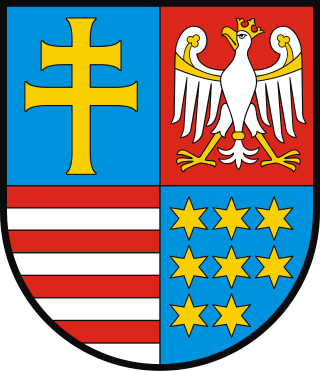
The coat of arms that serves as the symbol of the Świętokrzyskie Voivodeship, Poland, consists of the Iberian style escutcheon (shield), with square top and rounded base, that is divided in the 2 by 2 chessboard pattern. The top left field features a yellow patriarchal cross. The top right field features a white eagle with yellow crown, beak, legs, stripes on its wings, and a ring on its tail. The bottom left field features eight yellow six-pointed starts, placed in three rows, each with three stars, with the exception of the bottom row, that only had 2 stars, placed to the left.
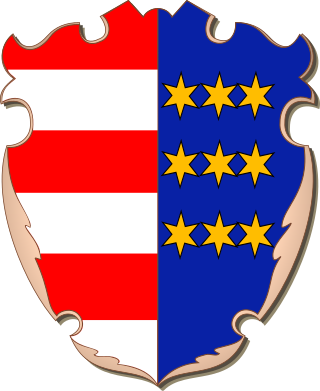
The historical coat of arms, that served as the symbol of the Sandomierz Land, and the Sandomierz Voivodeship of the Kingdom of Poland, from 14th to 18th centuries, was divided into two fields, with the left field consisting of six stripes, that were alternatining either between red and white, or red and yellow colours, and with the right field consisting of several yellow six-armed stars, which number altered between seven and nine.

The coat of arms that serves as the symbol of the Podlaskie Voivodeship, Poland is divided into two horizontal red fields. The top field depicts a white eagle, and a bottom field, a knight in a white (silver) armor, sitting on a white (silver) horse with a blue saddle and shabrack, and yellow (golden) harness, standing on its back hoofs. The knight has a blue shield with a yellow (golden) cross of Lorraine on it, put on his left arm, and hold a sword in his right hand. The current design of the coat of arms was designed by Tadeusz Gajl, and adopted in 2001.

The coat of arms of the town of Białogard, Poland, depicts a red griffin standing on its back legs, above the blue horizontal wavy line. The current coat of arms was established in 2004.

The flag, which serves as the symbol of the city of Białogard, West Pomeranian Voivodeship, in western Poland, is divided into three horizontal stripes, including a blue stripe in the middle, and two white stripes, twice its size, placed on top and bottom, and with two light red rhombuses, each placed in the left corner of white stripe. The flag was established in 2004.



















